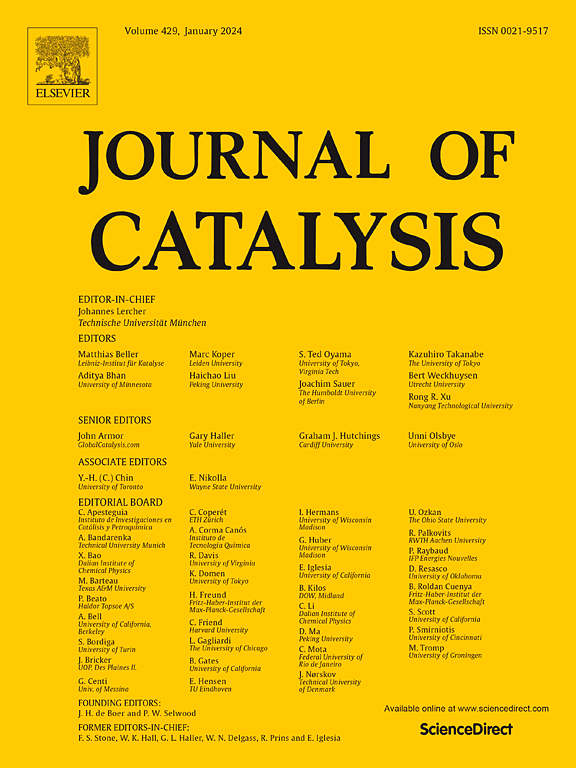利用基于第一性原理的动力学蒙特卡罗模拟阐明钾在甲烷蒸汽重整中的作用
IF 6.5
1区 化学
Q2 CHEMISTRY, PHYSICAL
引用次数: 0
摘要
在化学工业中,钾通常被用作促进剂来减少Ni催化剂表面的焦炭形成,并且已被证明可以显着提高甲烷蒸汽重整(MSR)反应的生产率。尽管进行了大量的研究,但对蒸汽重整条件下的钾效应还缺乏详细的了解。在这篇论文中,我们建立了基于第一性原理的Ni(11 11)和钾掺杂Ni(11 11)表面上MSR的KMC模型。采用聚类扩展(CE)方法系统地捕获了MSR物种之间吸附物-吸附物的相互作用及其对反应速率的影响。为了了解不同钾(0.5-3 %)在Ni(1 1 1)上的负荷对MSR净周转率和宏观覆盖率的影响,我们进行了KMC模拟。在高温下,我们发现钾强烈促进CH和碳吸附物的氧化。例如,在1273.0 K下,我们观察到掺钾Ni(1111)体系的MSR净周转率(K-Ni(1111)-2.8 %)大约是Ni(1111)的13.6倍。KMC过程统计分析表明,与Ni位点相比,关键氧化事件如CHO、CHOH、COH和CO的形成在钾位点上发生得明显更快。此外,在K- ni(1 11 1)-2.8 %,1273.0 K下,钾位点上的CO途径对MSR净周转率的贡献最大(约57 %),该途径需要甲烷完全脱氢为C,后者氧化为CO。我们的KMC模拟为钾在MSR中的作用提供了更深入的机械层面的理解,并可能有助于设计在蒸汽重整条件下表现出高活性和稳定性的下一代ni基催化剂。本文章由计算机程序翻译,如有差异,请以英文原文为准。

Elucidating the role of potassium in methane steam reforming using first-principles-based kinetic Monte Carlo simulations
In the chemical industry, potassium is commonly employed as a promoter to reduce coke formation on the Ni catalyst surface and has been demonstrated to significantly improve the productivity of the methane steam reforming (MSR) reaction. Despite numerous studies, a detailed understanding of the potassium effect at steam reforming conditions is lacking. In this contribution, we have developed a first-principles-based KMC model of MSR on Ni(1 1 1) and potassium-doped Ni(1 1 1) surfaces. The cluster expansion (CE) methodology was employed to systematically capture adsorbate–adsorbate interactions between MSR species and their effects on reaction rates. We performed KMC simulations with different loadings of potassium (0.5–3 %) on Ni(1 1 1) to understand the effect on MSR net turnover rates and macroscopic coverages. At high temperatures, we found that potassium strongly promotes the oxidation of CH and carbon adsorbates. For instance, at 1273.0 K, we observe that the MSR net turnover rate on the potassium-doped Ni(1 1 1) system (K-Ni(1 1 1)-2.8 %) is around 13.6 times higher than on Ni(1 1 1). The KMC process statistics analysis reveals that key oxidation events such as the formation of CHO, CHOH, COH and CO occur significantly faster on the potassium sites compared to Ni sites. Furthermore, on K-Ni(1 1 1)-2.8 % at 1273.0 K, the CO pathway on the potassium sites, which entails complete dehydrogenation of methane to C and oxidation of the latter to CO, makes the highest contribution (around 57 %) to the MSR net turnover rate. Our KMC simulations provide a deeper mechanistic-level understanding of the role of potassium in MSR and can potentially aid in the design of next-generation Ni-based catalysts that exhibit high activity and stability at steam reforming conditions.
求助全文
通过发布文献求助,成功后即可免费获取论文全文。
去求助
来源期刊

Journal of Catalysis
工程技术-工程:化工
CiteScore
12.30
自引率
5.50%
发文量
447
审稿时长
31 days
期刊介绍:
The Journal of Catalysis publishes scholarly articles on both heterogeneous and homogeneous catalysis, covering a wide range of chemical transformations. These include various types of catalysis, such as those mediated by photons, plasmons, and electrons. The focus of the studies is to understand the relationship between catalytic function and the underlying chemical properties of surfaces and metal complexes.
The articles in the journal offer innovative concepts and explore the synthesis and kinetics of inorganic solids and homogeneous complexes. Furthermore, they discuss spectroscopic techniques for characterizing catalysts, investigate the interaction of probes and reacting species with catalysts, and employ theoretical methods.
The research presented in the journal should have direct relevance to the field of catalytic processes, addressing either fundamental aspects or applications of catalysis.
 求助内容:
求助内容: 应助结果提醒方式:
应助结果提醒方式:


